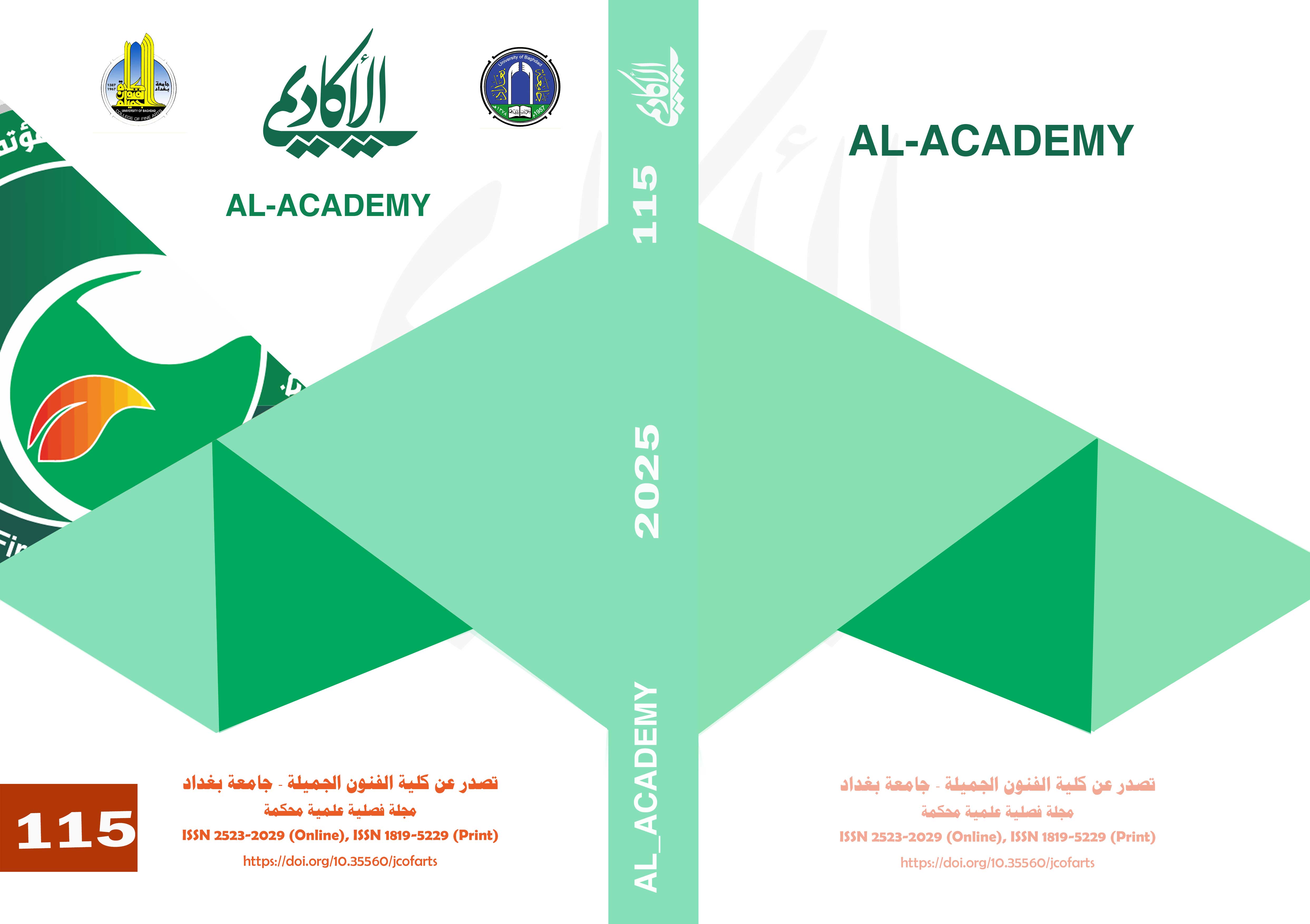Abstract
The research entitled (Irregularity in the Structure of Calligraphy ) deals with how to leave the fixed patterns to unfamiliar linear patterns that break the monotony of the organization and activate the dynamic directionality, thus bypassing the closedness of the system in achieving the linear formation and moving to formations that are based in their operational basis on irregularity without going beyond the principles of the rules, but rather starting from them. Due to the combination of rules and principles and contemporary perceptions represented by leaving the stereotypical and searching for new forms of expression that were processed according to the calligrapher’s aesthetic experience and design sense, there are calligraphic formations that embody the concept of disorder in terms of their organizational structure, based on their becoming a visual achievement founded on a modernist vision.
It included four chapters, the first of which dealt with presenting the research problem, its importance and the need for it, explaining the concept of disorder and the mechanism of its operation that the calligrapher relies on in his calligraphy composition, towards a new and different curve based on the act of confirming the harmony between meaning and structure and embodying them in calligraphic formations, which in turn constitute qualitative additions of Aesthetic and expressive orientations. The second chapter included the theoretical framework through sections that dealt with the philosophy of order in art in general, including the art of Arabic calligraphy, as well as the features of the linear structure. This was then followed by indicators of the theoretical framework. As for the third chapter, it included research procedures and analysis of calligraphic applications according to the foundations of analysis. Designed to achieve the research objectives, the fourth chapter included presenting the results and conclusions and concluding the research
It included four chapters, the first of which dealt with presenting the research problem, its importance and the need for it, explaining the concept of disorder and the mechanism of its operation that the calligrapher relies on in his calligraphy composition, towards a new and different curve based on the act of confirming the harmony between meaning and structure and embodying them in calligraphic formations, which in turn constitute qualitative additions of Aesthetic and expressive orientations. The second chapter included the theoretical framework through sections that dealt with the philosophy of order in art in general, including the art of Arabic calligraphy, as well as the features of the linear structure. This was then followed by indicators of the theoretical framework. As for the third chapter, it included research procedures and analysis of calligraphic applications according to the foundations of analysis. Designed to achieve the research objectives, the fourth chapter included presenting the results and conclusions and concluding the research
Keywords
Irregularity Structure formation
Abstract
يتناول البحث الموسوم (اللانظام في بنية التكوينات الخطية ) كيفية مغادرة الانساق الثابتة الى انساق خطية غير مألوفة تكسر رتابة التنظيم وتفعل الاتجاهية الحركية متجاوزة بذلك انغلاقيه النظام في انجاز التكوين الخطي والانتقال الى تكوينات تستند في اساسها الاشتغالي على اللانظام من دون التجاوز على الاصول القواعد بل انطلاقا منها بفعل الممازجة بين القواعد والاصول وبين التصورات المعاصرة المتمثلة بمغادرة النمطي والبحث عن مثابات جديدة للتعبير المخرجة وفق الخبرة الجمالية للخطاط وحسه التصميمي، أذ يمكن رصد تكوينات خطية تجسد مفهوم اللانظام من حيث بنائها التنظيمي مستندة في تصيرها كمنجز بصري متأسس برؤية حداثوية.
تضمنت أربعة فصول ،تناول الفصل الأول منها طرح مشكلة البحث وأهميته والحاجة إليه ، بيان مفهوم اللانظام والية اشتغاله التي يعول عليها الخطاط في تكوينه الخطي بما ينحو منحناً جديداً مغايراً يستند الى فعل تأكيد الموائمة بين المعنى والمبنى وتجسدها في تكوينات خطية التي بدورها تشكل اضافات نوعية ذات توجهات جمالية وتعبيرية اما الفصل الثاني فقد اشتمل على الاطار النظري عبر مباحث تناولت فلسفة اللانظام في الفن عموما ومنها فن الخط العربي فضلا عن سمات البنية الخطية و ، ثم اعقبتها مؤشرات الاطار النظري، اما الفصل الثالث فقد اشتمل على اجراءات البحث وتحليل التطبيقات الخطية وفق مرتكزات التحليل المعدة لتحقيق اهداف البحث، اما الفصل الرابع فقد تضمن عرض نتائج والاستنتاجات وختم البحث
تضمنت أربعة فصول ،تناول الفصل الأول منها طرح مشكلة البحث وأهميته والحاجة إليه ، بيان مفهوم اللانظام والية اشتغاله التي يعول عليها الخطاط في تكوينه الخطي بما ينحو منحناً جديداً مغايراً يستند الى فعل تأكيد الموائمة بين المعنى والمبنى وتجسدها في تكوينات خطية التي بدورها تشكل اضافات نوعية ذات توجهات جمالية وتعبيرية اما الفصل الثاني فقد اشتمل على الاطار النظري عبر مباحث تناولت فلسفة اللانظام في الفن عموما ومنها فن الخط العربي فضلا عن سمات البنية الخطية و ، ثم اعقبتها مؤشرات الاطار النظري، اما الفصل الثالث فقد اشتمل على اجراءات البحث وتحليل التطبيقات الخطية وفق مرتكزات التحليل المعدة لتحقيق اهداف البحث، اما الفصل الرابع فقد تضمن عرض نتائج والاستنتاجات وختم البحث
Keywords
اللانظام، البنية، التكوين
